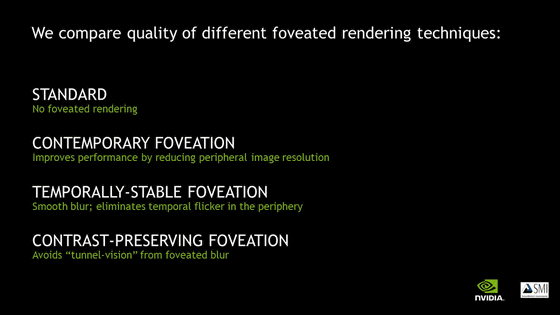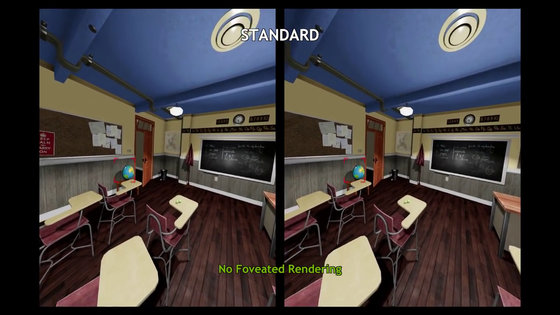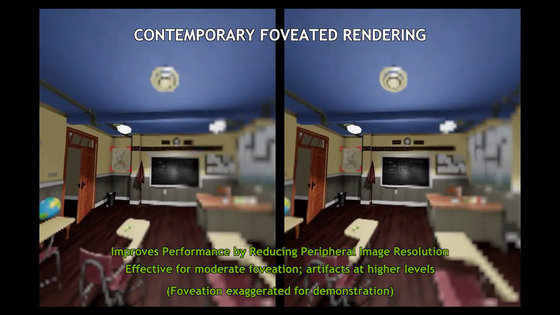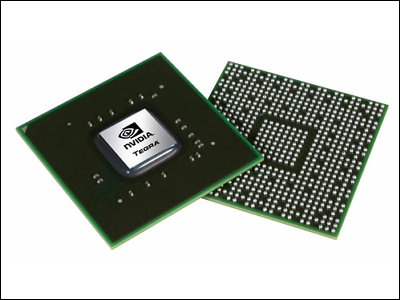NVIDIA will showcase new technology to increase VR's immersive feeling and reduce rendering load

BySamantha Cristoforetti
The range that human beings can see with both eyes is said to be about 120 degrees to the left and right, except for the point of sight, it is called "peripheral vision", and it is in the "blurred and visible" area that can be seen but can not be recognized I will. NVIDIA and Germany's SensoMotoric Instruments (SMI) are developing the technology "Foveated Rendering" (foveated rendering), which attempts to reduce the rendering load of VR by realistically reproducing the human visual field.
NVIDIA Partners with SMI on Innovative VR Rendering Technique
https://blogs.nvidia.com/blog/2016/07/21/rendering-foveated-vr/
NVIDIA announced that it has signed a partner agreement with SMI to develop innovative rendering technology for VR. Researchers at NVIDIA have developed the "Foveated Rendering" technology that renders videos close to the human vision for VR, making full use of the latest eye-tracking technology developed by SMI.
You can see how this "Foveated Rendering" technology is based on the following movie.
Improving VR with NVIDIA's Foveated Rendering - YouTube
The video that appears in the movie is "STANDARD (normal VR image)", "CONTEMPORARY FOVEATION (reducing the rendering load by lowering the resolution other than the center of the image)" "TEMPORALLY-STABLE FOVEATION Blurring peripheral images reduces flicker in the peripheral vision) "" CONTRAST - PRESERVING FOVEATION "(avoiding narrowing the field of view by blurring with contrast left)".

"STANDARD (normal VR image)"

Since it is a video for VR, the same image is displayed on the left and right. The line of sight is facing the red frame part (in the case of the following images, the globe part) in the vicinity of the center of the left and right screens, you can see how you are tracking this line of sight. In addition, STANDARD is an image for normal VR, very high resolution from the corner to the corner of the image.

In "CONTEMPORARY FOVEATION", you can see that the resolution other than the center (eye gaze) of the image is decreasing. This is a measure to reduce the load when rendering VR images.

"TEMPORALLY-STABLE FOVEATION" that blurred to render the low resolution rendering of the peripheral visual field more naturally. This reduces flicker in the peripheral visual field.

Furthermore, it is "CONTRAST - PRESERVING FOVEATION" to avoid narrowing the field of view by leaving a contrast in the blurred part of the peripheral visual field. Like the "TEMPORALLY-STABLE FOVEATION", the image of the peripheral visual field portion is of low resolution, but increasing the contrast of the blurred portion reduces the sense of incompatibility of the blur, and it is thought that the visual field is narrowing It will not become.

According to the research team of NVIDIA, it seems that the flicker of the image which occurred when the peripheral vision is set to low resolution was due to the reduction of the contrast due to the blurring processing. Furthermore, by performing the blurring process while maintaining the contrast of the image before the blurring processing, the user can tolerate double blur.
In addition, Mr. Anjul Pathney, one of NVIDIA's researchers, said, "Since VR requires higher frame rates and resolutions than before, it reduces the resolution and reduces the rendering load Foveated Rendering will be a very important technology. "
Related Posts:






